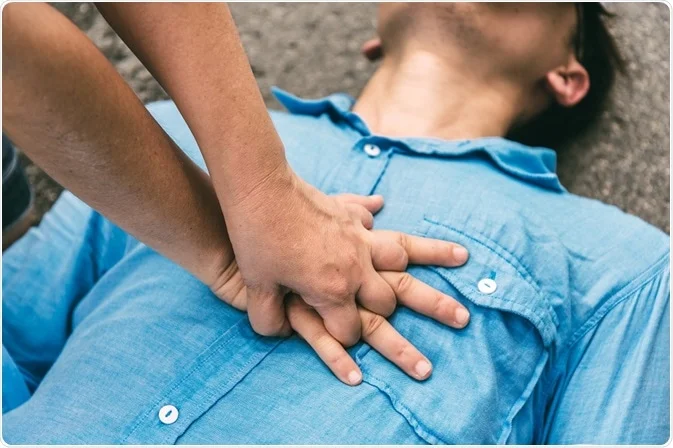The AHA releases new recommendations that say bystanders can skip mouth-to-mouth resuscitation and use Hands-Only CPR to help an adult who suddenly collapses. If playback doesnt begin shortly try restarting your device.
 Chest Compression Operation In Cpr Adapted From 12 Download Scientific Diagram
Chest Compression Operation In Cpr Adapted From 12 Download Scientific Diagram
Performing chest compressions is one of the most important components of life-saving resuscitation.

Cpr chest compressions. Keep performing cycles of chest compressions and breathing until the person exhibits signs of life such as breathing an AED becomes available or EMS or a trained medical responder arrives on scene. How to perform CPR adults. Check for breathing.
End the cycles if the scene becomes unsafe or you cannot continue performing CPR due to exhaustion. Is not breathing or is breathing abnormally. Cardiopulmonary resuscitation CPR is a combination of techniques including chest compressions designed to pump the heart to get blood circulating and deliver oxygen to the brain until definitive treatment can stimulate the heart to start working again.
CPR involves chest compressions for adults between 5 cm 20 in and 6 cm 24 in deep and at a rate of at least 100 to 120 per minute. 7 Its far better to do something than to do nothing at all if you are afraid and doubtful of your knowledge and abilities. Is not responding to you.
A simple flowchart can improve motivation and the quality of performance. Hence the most important component of CPR is chest compressions. After every 30 chest compressions give 2 rescue breaths.
In the 2015 CPR guideline update the rate changed from 100 compressions per minute. Furthermore guidelines do recommend a chest compression CC-only algorithm for dispatcher-assisted bystander resuscitation. The maximum interval for pausing chest compressions is 10 seconds.
CPR involves chest compressions and mouth-to-mouth rescue breaths that help circulate blood and oxygen in the body. If youre not completely confident attempt hands-only CPR instead. Start CPR with 30 chest compressions before giving two rescue breaths.
When chest compressions are done at 100-120 per minute the idea is to be exact or in-between 100 and 120. Chest compressions are the first line response in CPR. Perform 30 chest compressions.
Chest Compressions CPR Steps - YouTube. Make sure your heel is not at the very end of the breastbone. Place the heel of your hand on the centre of the persons chest then place the other hand on top and press down by 5 to 6cm 2 to 25 inches at a steady rate of 100 to 120 compressions a minute.
If you are hesitant to do mouth-to-mouth chest compressions alone may still be life-saving. If there is no breathing or a pulse within 10 seconds begin chest compressions. Too fast or too slow does not always provide adequate perfusion.
So two or three fingers it is. Aim of the study Bystander-initiated basic life support BLS for the treatment of prehospital cardiac arrest increases survival but is frequently not performed due to fear and a lack of knowledge. A heart attack occurs when part of the heart is starved of oxygen.
If youve previously received CPR training but youre not confident in your abilities then just do chest compressions at a rate of 100 to 120 a minute. The rescuer may also provide artificial ventilation by either exhaling air into the subjects mouth or nose mouth-to-mouth resuscitation or using a device that pushes air into the subjects lungs mechanical ventilation. Repeat until an ambulance or automated external defibrillator AED arrives.
It is the same for adults children and babies. For healthcare providers and those trained. Perform two rescue breaths.
Everyone should learn it as it would make the world a safer place for everyone. You should start CPR if a person. If they are not breathing start CPR.
Start CPR as soon as possible. Place the heel of one hand on the breastbone -- just below the nipples. This can help keep the brain and vital organs alive.
You only need to aim for at least 13 the depth of the chest and since infants are small and fragile using even one hand is too much pressure and can end up breaking bones or causing organ damage. Conventional CPR using chest compressions and mouth-to-mouth breathing at a ratio of 302 compressions-to-breaths. Remember that CPR is a life-saving technique.
In fact in many cases particularly those in which the person resuscitating is untrained compression-only CPR that is resuscitation without rescue breathing is actually recommended. How do you position your hands during CPR. 100-120 compressions per minute.
This is an established recommendation based on the need to maintain blood flow to the heart during a cardiac arrest. At what rate do you perform CPR compressions. For infant CPR only two or three fingers to perform chest compressions.
20 In Hands-Only CPR bystanders dial 9-1-1 and provide high-quality chest compressions by pushing hard and fast in the center of the victims chest. Keep your other hand on the childs forehead keeping the head tilted back. Chest Compressions CPR Steps Watch later.
